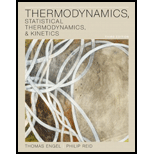
Real walls are never totally adiabatic. Use your experience to order the following walls in increasing order with respect to their being diathermal: 1-cm-thick concrete, 1-cm-thick vacuum, 1-cm-thick copper, 1-cm-thick cork.
Interpretation:The increasing order of the given walls with respect to their diathermal property needs to be determined.
Concept Introduction: Thermodynamics is the branch of chemistry that deals with heat exchange between system and surroundings. The thermodynamic process can be classified into two types; isothermal and adiabatic process. An isothermal process occurs at a constant temperature between the system and surroundings. On the contrary, adiabatic processes do not allow the transfer of heat.
Answer to Problem 1.1CP
Explanation of Solution
Given information:The real walls are never totally adiabatic.
An adiabatic process doesnot allow the transfer of heat through it. A diathermal wall can be defined as the wall separating two thermodynamic systems in which transfer of heat takes place but transfer of matter is not allowed.
Hence the amount of heat transfer will depend on the heat capacity of the diathermal wall. In the given options, the copper wall will be more diathermal as it has the highest heat capacity compared to concrete, cork and vacuum. Whereas vacuum will be least diathermal due to the least heat capacity.
Thus, the increasing order of diathermal capacity is as follows:
Want to see more full solutions like this?
Chapter 1 Solutions
Thermodynamics, Statistical Thermodynamics, & Kinetics
Additional Science Textbook Solutions
Inorganic Chemistry
Chemistry
Principles of General, Organic, Biological Chemistry
Chemistry: Atoms First
Chemistry: Structure and Properties (2nd Edition)
- Computers are not supposed to be in very warm rooms. The highest temperature tolerated for maximum performance is 308 K. Express this temperature in C and F.arrow_forwardConsider a container of volume 40.0 dm3 that is divided into two compartments of equal size. In the left compartment there is helium at 1.0 atm and 25C; in the right compartment there is argon at the same temperature and pressure p= 2 atm. What are G, S and H for the process occurring when the partition is removed. Assume that the gases are perfect.arrow_forwardCalculate the final pressure of a sample of water vapour that expands reversibly and adiabatically from 87.3 Torr and 500 cm3 to a final volume of 3.0 dm3. Take (gamma) γ = 1.3. ANs in t0rrarrow_forward
- A thermally insulated container (closed system) is dropped from a certain height andfilled with water so that it collides inelastically against the ground. what should be the valueof the height in m so that the temperature of the water increases by 0.5 °C? Suppose thatall the energy lost in the fall is invested in increasing the temperature of the water.I considered a gravitational acceleration of 9.81 m/s2.arrow_forwardFind DSsys and DSsurr if 3.000 mole of argon is expanded reversibly and isothermally from a volume of 500.0 L to a volume of 2500. L at 298.15 K.arrow_forwardA propane barbeque tank is filled in the winter at -15ᵒC to a pressure of 2500 kPa. What will the new pressure be in the summer if the temperature rises to 20ᵒC.arrow_forward
- Calculate the final pressure of a sample of carbon dioxide that expands reversibly and adiabatically from 67.4 kPa and 0.50 dm3 to a final volume of 2.00 dm3. Take γ = 1.4.arrow_forwardWhat Is The Ideal-Gas Equation of State?arrow_forwardA manometer was connected to a bulb containing nitrogen under slight pressure. The gas was allowed to escape through a small pinhole, and the time for the manometer reading to drop from 65.1 cm to 42.1 cm was 18.5 s. When the experiment was repeated using a fluorocarbon gas, the same fall took place in 82.3 s. Calculate the molar mass of the fluorocarbon.arrow_forward
- Provide a particle level explanation for the following: when the temperature of a sealed, rigid (non-flexible) container is decreased, pressure also decreases.arrow_forwardIf the rubber band was stretched isothermally, would heat need to be absorbed or emitted to maintain a constant temperature?arrow_forwardIn July in Los Angeles, the incident sunlight at ground level has a power density of 1.2 kW m−2 at noon. A swimming pool of area 50 m2 is directly exposed to the Sun. What is the maximum rate of loss of water? Assume that all the radiant energy is absorbed; take the enthalpy of vaporization of water to be 44 kJ mol−1.arrow_forward
 Chemistry: Principles and ReactionsChemistryISBN:9781305079373Author:William L. Masterton, Cecile N. HurleyPublisher:Cengage Learning
Chemistry: Principles and ReactionsChemistryISBN:9781305079373Author:William L. Masterton, Cecile N. HurleyPublisher:Cengage Learning
